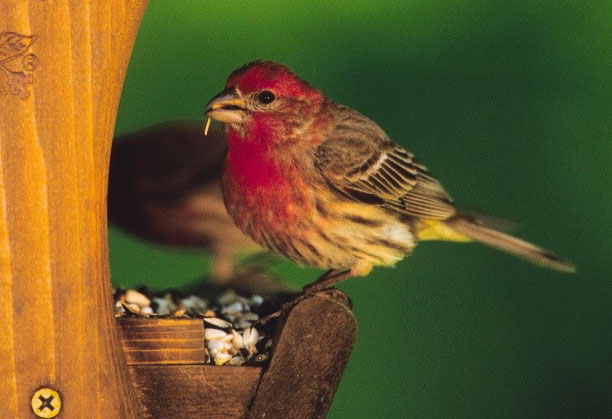I’m starting with house finches because they are common throughout the United States.
The house finch has not always been found in the eastern United States. In 1940, they were illegally captured in California and imported to New York by pet dealers. Fearing prosecution, the dealers released their “Hollywood Finches” on Long Island in 1940. Since then the finches have spread to all corners of the East and have even rejoined their relatives in the West.
Populations of house finches found east of the Rockies are rarely found far from urban or suburban areas, but in its native western range they may also be found in a wide variety of open or semi-open habitats including undisturbed deserts.
House finches differ from purple finches by the male purple finch’s purple side streaks (unlike the brown streaks in a house finch) and by the female’s conspicuous eye stripe (female house finches lack this feature).
Male house finches display a wide variety of plumage coloration ranging from gray to bright crimson. The coloration comes from carotenoid pigments found in some wild foods. The more pigment present in the foods eaten when they are molting new feathers … the redder the male. Female house finches prefer to mate with the reddest males they can find.
House finches are early nesters, beginning in March in most of the country. Both male and female house finch display a strong tendency to return to the same area to breed, often occupying the same nest site as the previous year. House finches rarely use birdhouses; instead they seem to prefer locations such as coniferous trees, cactus plants, ledges, street lamps, ivy on buildings and hanging planters. Typically, they produce at least two broods each nesting season.
A water source can be a strong attractant for house finches. They can drink up to 40% of their body weight on a hot summer day. Also fond of nectar, they can become a nuisance at hummingbird feeders. If they do, offer them a dish of nectar for their own use.
House finches’ diets are the most vegetarian of any North American bird; approximately 97% of their diet is made up of vegetable matter including buds, seeds, and fruits. Strongly attracted to feeders, they prefer sunflower or safflower seeds. They will also eat at thistle seed feeders.
Unlike most other seed-eating birds, finches do not switch to an insect diet during the summer nesting season. They continue to eat mostly seeds, although they will occasionally prey on some insects when they are abundant.
The Eastern population of house finches has decreased due to an eye disease known as avian conjunctivitis. Studies have shown that when the avian conjunctivitis enters a new area, it takes three years before the population of house finches stabilizes at about half of the pre-disease level. It is theorized that transmission of avian conjunctivitis among house finches is dependent on high-density populations.
Banding studies show house finches may live to be over 11 years old in the wild.
Have you seen house finches in your yard?


I have a number of house finches in my backyard. I have 20+ feeders. What would you suggest as to putting up nesting sites? I had a couple little bird houses up years ago and they built nests on the slanted roof that eventually slid off once the fledglings got too heavy. How big a platform and what kind of location should it be located in? Our past bird house was sheltered by some shrubbery but that is gone now.
In my experience, house finches do not usually nest inside birdhouses. They’re much more likely to nest in a spring wreath on my front door (very messy) or in a hanging pot with a plant. Mostly they nest in trees, and they don’t seem to be fussy about what type of tree. I feed golden safflower seeds and they love it, but I’ve also had success with white safflower and black oil sunflower seeds.